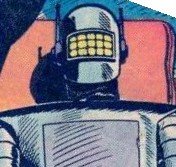
Though the director had made four films prior,"The Lodger: A Story of the London Fog" (its official title) is frequently referred to as the first "true Hitchcock film." The film includes a cool blonde subject to grave danger, inept local police, mistaken identity, and an overbearing mother -- all themes and motifs which would become constants in the Hitchcock oeuvre. Though it's a silent, black and white, 1927 film (with 1927 sensibilities), it is actually quite fun to watch, as it serves to provide clear antecedents for many of Hitchcock's later films.
The story centers on a London soaked in fear. A Jack the Ripper-type strangler is on the loose, snuffing out young blonde women. The fear is so widespread, blonde flappers are wearing brunette wigs. Daisy Bunting (described in the credits as a "mannequin" -- a clothes model), though, couldn't care less. She scoffs at the other platinum's fears.
Daisy and her family run a boarding house and Daisy (though betrothed to a member of London's finest) has her eyes on Mr. Drew, a man who's just started renting an upstairs room. She's smitten by the mysterious stranger who a) wears clothes similar to those of "The Avenger" (the killer on the loose) and b) wants all of the paintings of blonde women which hang in his room to be turned toward the wall.
Daisy and Mr. Drew exchange affections, much to the anger and chagrin of Daisy's cop-fiancee.
At the fiancee's urging, the police bear down on Mr. Drew. They search his room and find a gun and a photograph of a blonde woman. Drew tries to explain, saying that, in face, he is also on the hunt for The Avenger -- the man who had killed his sister (a young blonde). Blinded by jealousy, the policeman slaps handcuffs on Drew (the manacles serving as another image which Hitchcock would use often, over the subsequent years) and prepare to run him in. Drew, though, escapes, running off into town.

Daisy meets up with Drew in the town, but a lynch mob have assembled to execute justice. Drew falls from a ledge and his handcuffs catch on a high iron fence, hanging him from his wrists. As the mob descends, the police arrive to say that they have, in fact, found the real Avenger (in the act of killing) and that Drew is innocent. Daisy's fiancee apologizes, and Daisy goes to Drew to comfort him.
Like "M" (a 1931 German expressionist film by Fritz Lang), "The Lodger" deals, explicitly, with the mob mentality and the destructive nature of widespread fear. All of London is foaming with the rabies of revenge (ironic, considering the killer has termed himself "The Avenger"). Their rage is so blind that they nearly kill an innocent man.

Ivor Novello (Mr. Drew) is watchable as the innocent protagonist (a role played, to some degree, by Cary Grant, Henry Fonda and, even, Grace Kelly in later films). The other actors feel like they are overacting, though (this being a silent film, in the silent film era, was not uncommon).
Overall, it feels like an important film, but one only for true fans of Hitchcock. The director, himself, referred to it as his "first film" and it certainly shows promise. The English film industry was in a troubled state at this point in cinema history -- snowed under by heaps of quality product coming from the rest of Europe (particularly Germany) and especially the United States. Hitchcock, by way of "The Lodger," became a beacon of hope for the English film business -- a promise that something new and creative and riveting could come from the island nation.
The Lodger 1927
Starring: Ivor Novello, Jane, and Malcolm Keen
Written by: Marie Belloc Lowndes

2 comments:
I've never heard of this one. Your description of the mob mentality aspect of the story reminded me of a western I saw recently called The Oxbow Incident. Only there is no "nearly" in their treatment of the innocent. Their mob vengeance is swift and complete. Dark tales, both.
I'm intrigued by the similarity, in that photo of the woman and the lodger at the door, to the house layout in Psycho.
Not uncommon! The hallway-to-one-side, stairs-to-the-other was seen in Psycho, The Wrong Man, Vertigo and (to some degree) Shadow of a Doubt.
Post a Comment